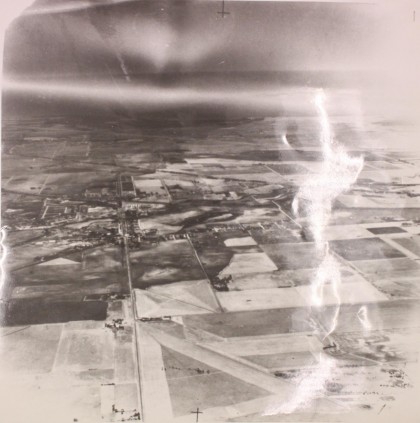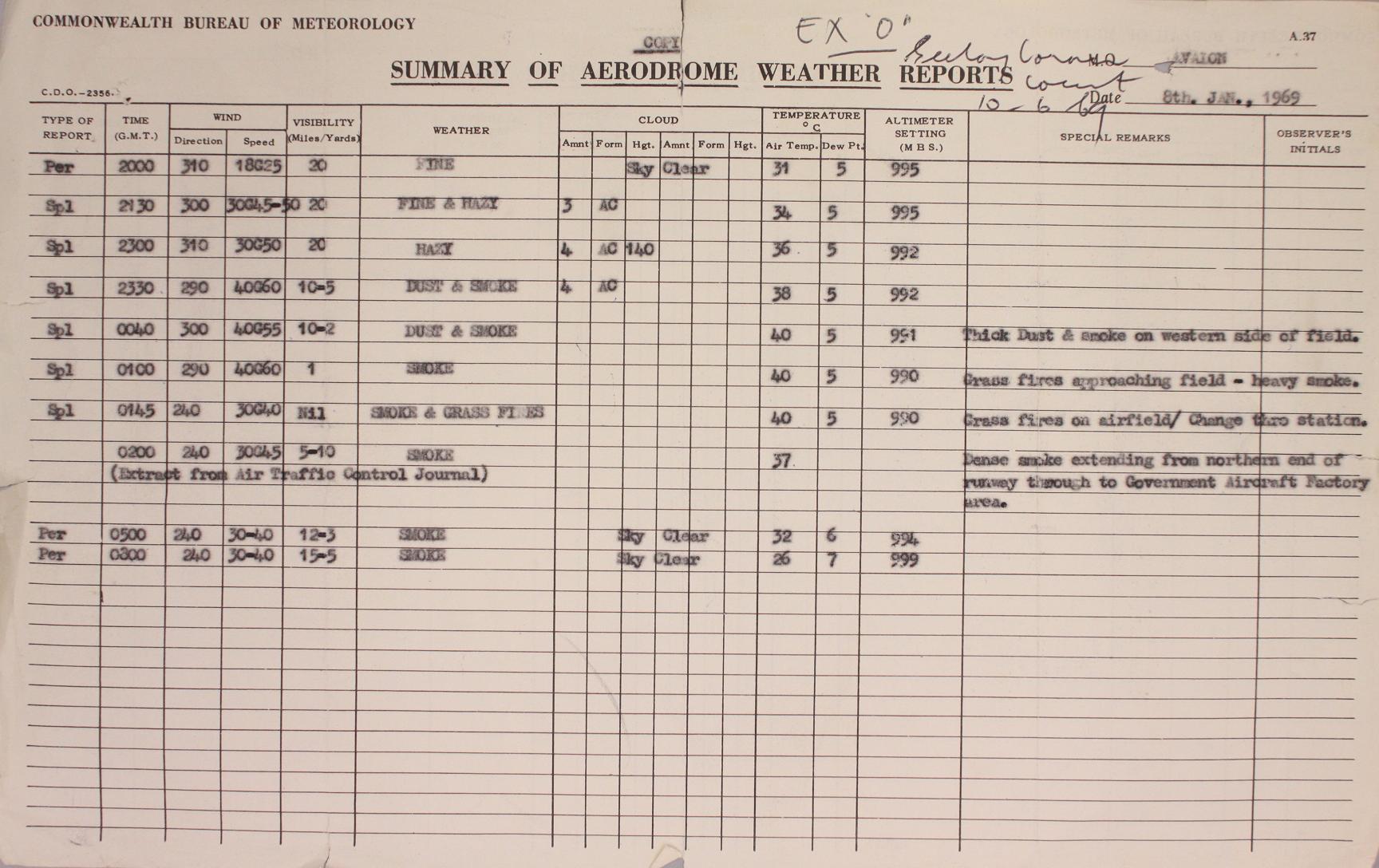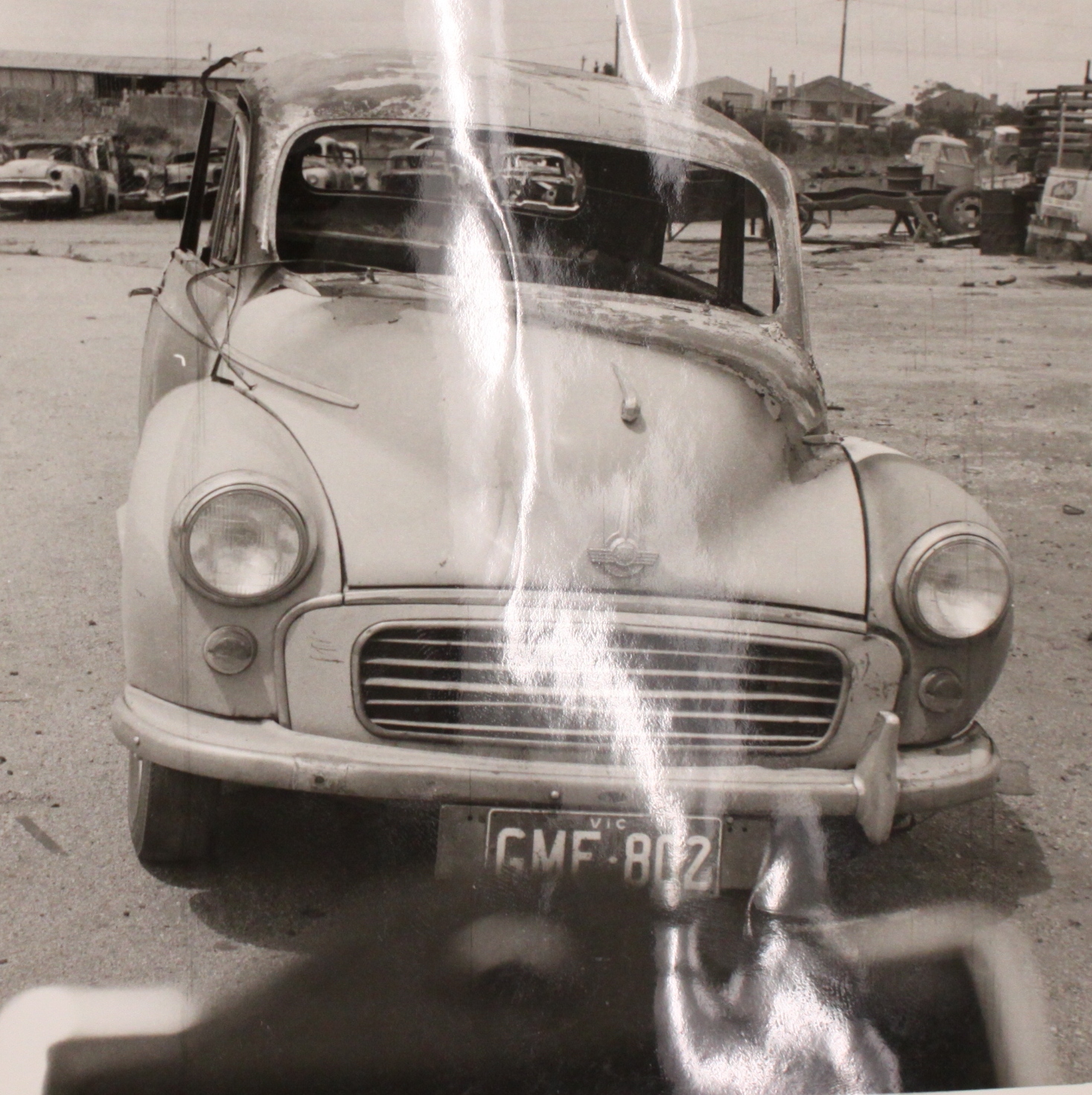Author: Phoebe Wilkins
Parched land, plumes of smoke and burning embers. All of these phrases have been in the headlines in the last few weeks since the devastating fires raged to the north of Melbourne, fires which are still smouldering. These fires are not the first to cause devastation across the state as Victoria has a long history of bushfires.

vprs 24-P2-Unit 293-Item 1969_1054 Aerial photograph Lara - Just over five years ago Victoria watched the 'Black Saturday' fires cause immeasurable damage, including loss of property, livestock and lives. However, this is not the first time that Victoria has been razed by fire. In fact 'Black Saturday' and the more recent fires of February 2014 are just a number in a long line of bushfires that have impacted on Victoria and Victorians.
On Friday 13 January 1939, in the peak of summer, as hot northerly winds played havoc, Victoria was once again alight. On “Black Sunday”, thirteen years earlier, almost to the day Warburton was ravaged by fire. Now, more than a decade on, Warburton, along with Yarra Glen, Woods Point and as far as Mansfield, the Grampian Ranges and the Otway Ranges were again burning. This time the fires covered over 1.5 million hectares of land and claimed seventy-one lives, up to 1300 buildings and completely destroyed the town of Narbethong. The fires that ripped through Warburton, St Clair, Woods Point and Matlock on their own claimed seventeen lives. At James Michael Fitzpatrick’s Mill at St Claire, near Matlock the fire claimed fifteen of those lives; one person lost their life at Yelland’s Mill at St Clair and one woman, Vera Ada Maynard died from ‘effects of suffocation and burns caused when they were overtaken by a bushfire (sic)’. The forest and the mills that these men were working in would have been the perfect dry tinder for the fire to latch on to, and evidently cause further deaths in the area.
Photographs from the inquest show trees and land blackened by fire, unrecognisable bodies and the utter destruction of the saw mills, of which a total of 69 timber mills were destroyed.
Only a few years later in early 1944 whilst Australians were overseas fighting the battle of the Second World War, fires tore through Victoria again. Forty-nine lives were lost, more than five hundred homes and vast amounts of livestock was destroyed in ferocious fires that covered over one million hectares of land. The Central and Western districts, including Hamilton, Dunkeld, Skipton and Lake Bolac were deeply affected, as well as plant works in Morwell and Yallourn.
However, another fire in Woodend would prove fatal with the death of a woman in her 70s. As it happens, this particular fire would also take place on 13 January, and an inquest into Sarah Lugg’s death was held at the Woodend Court House in May 1944. Her inquest details how ‘the fire had evidently started near a small rubbish tip in [a] paddock, on the side of a hill about 150 yards south of [the] dwelling house and 50 yards away from the milking sheds.’ Once this fire had been ignited it seemed as if it would be a matter of time that it would erupt into something larger with ‘the conditions on that day…conducive to the rapid spread of fire. The temperature was high with a strong north to north west wind blowing which caused the fire to frequently change direction over a wide front.’
Sarah Lugg had packed her belongings into two suitcases and along with Bridget Connelly, whom she had known for sixty years, the two made the decision to flee the dense smoke and retreat to an open paddock for safety. However, it appears that Lugg that retreated on her own, with Connelly eventually making her way to the paddock to find that she was not there. By this time the fire had swept across Ashbourne Road, taking in its path the life of Sarah Lugg.
Forty-five years ago on the 8 January 1969 total and utter devastation would befell the small community of Lara, between Geelong and Melbourne. However this destruction would be widespread, affecting communities across the state and even the country.

"Summary of Aerodrome Weather Reports" - The weather and conditions the day of the Lara Fires (8 Jan 1969) - Conditions during the 7 and 8 January were hot and windy, the perfect combination for the fast and the wide spread of fire. An initial fire broke out on Tuesday 7January near Anakie at a large grazing property called Woollomanata, close to Lara. This fire was contained before it broke out again on the 8 January. In the inquest held at the Geelong Coroner’s Court on the 9 and 10 June 1969 the coroner stated that ‘the evidence adduced [did] not enable [him] to say what was responsible [for the fire], or perhaps, further, who was responsible, if anybody, for the starting of the first fire.’ There was contention as to whether the initial fire was ignited by a spark from a passing truck or caused from a cigarette butt thrown from a car.

vprs 24-P2-293-1969_1054 Photo 13
Whilst this was never established, the facts of the fire detailed in the coroner’s inquest, along with news reports and eye witness accounts from the day are all wracked with tragedy and devastation. The losses from the fire included thousands of livestock, the destruction of many homes and properties, grievous bodily injuries and the death of 18 people.
From the eighteen lives that were lost on this day, 17 of them had been caught on the Princes Highway at Lara in their vehicles. The fast moving grass fire had caused thick smoke, which in turn caused low visibility along the highway. Eye witness accounts from the day describe the panic and terror that ensued as people decided to flee their cars and attempt to outrun the fire. Ultimately this decision took the lives of seventeen people, including one family and several members of others. The tragic circumstances of the day have also helped in establishing the changing of guidelines for people in cars during bushfires.
Bushfires are a part of Victoria’s history, and no doubt will be a part of our future. The tragic events detailed here are just a small handful of Victoria’s bushfire history, with PROV holding a large and varied range of records relating to events and outcomes surrounding these wild forces of nature.
A selection of available sources at PROV:
Black Saturday bushfires Royal Commission (digitised online) - VPRS 16295/P3
Bushfire inquest – VPRS 24/P0/1379 1939/818
Sarah Lugg inquest – VPRS 24/P0/1492 1944/507
Lara bushfire inquest – VPRS 24/P2/293 1969/1054
Material in the Public Record Office Victoria archival collection contains words and descriptions that reflect attitudes and government policies at different times which may be insensitive and upsetting
Aboriginal and Torres Strait Islander Peoples should be aware the collection and website may contain images, voices and names of deceased persons.
PROV provides advice to researchers wishing to access, publish or re-use records about Aboriginal Peoples
